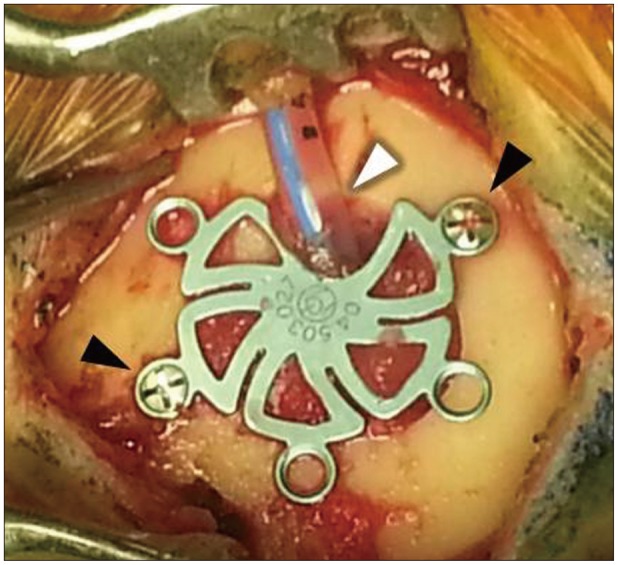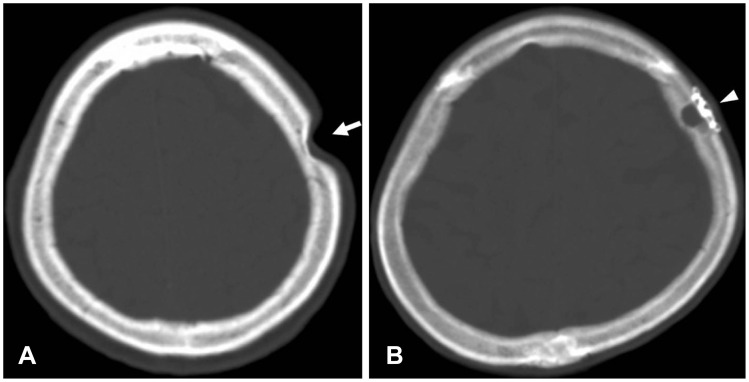Korean J Neurotrauma.
2014 Oct;10(2):76-81. 10.13004/kjnt.2014.10.2.76.
The Efficacy of Titanium Burr Hole Cover for Reconstruction of Skull Defect after Burr Hole Trephination of Chronic Subdural Hematoma
- Affiliations
-
- 1Department of Neurosurgery, Daegu Fatima Hospital, Daegu, Korea. paulyoonsoolee@hanmail.net
- KMID: 2256235
- DOI: http://doi.org/10.13004/kjnt.2014.10.2.76
Abstract
OBJECTIVE
Although burr hole trephination is a safe and effective surgical option to treat patients with chronic subdural hematoma (CSDH), it often results in a small but undesirable scalp depression from burr hole defect. This study is to evaluate the efficacy of titanium burr hole cover (BHC) for reconstruction of skull defects in these patients.
METHODS
A hundred and ninety-six cases of burr hole trephinations for CSDHs between January 2009 and December 2013 were assigned into two groups; Gelfoam packing only (GPO) and reconstruction using titanium BHC group, according to the modalities of burr hole reconstructions. The incidences and depths of scalp depressions and incidences of postoperative complications such as infections or instrument failures were analyzed in both groups. We also conducted telephone surveys to evaluate the cosmetic and functional outcomes from patient's aspect.
RESULTS
Significantly lower incidence (p<0.0001) and smaller mean depth (p<0.0001) of scalp depressions were observed in BHC than GPO group. No statistical differences were seen in postoperative infection rates (p=0.498) between the two groups. There were no instrument failures in BHC group. According to the telephone surveys, 73.9% of respondents with scalp depressions had cosmetic inferiority complexes and 62.3% experienced functional handicaps during activities of daily life.
CONCLUSION
Titanium BHC is highly effective for reconstruction of skull defect after burr hole trephination of CSDH, and provides excellent cosmetic and functional outcomes without significant complications.
MeSH Terms
Figure
Cited by 2 articles
-
A Simple Method for Reconstruction of the Temporalis Muscle Using Contourable Strut Plate after Pterional Craniotomy: Introduction of the Surgical Techniques and Analysis of Its Efficacy
Jin-Hack Park, Yoon-Soo Lee, Sang-Jun Suh, Jeong-Ho Lee, Kee-Young Ryu, Dong-Gee Kang
J Cerebrovasc Endovasc Neurosurg. 2015;17(2):93-100. doi: 10.7461/jcen.2015.17.2.93.Cosmetic outcome after electrocautery versus non-electrocautery dissection of the temporalis muscle for pterional craniotomy
Sang-Woo Lee, Yoon-Soo Lee, Min-Seok Lee, Sang-Jun Suh, Jeong-Ho Lee, Jin-Wook Kim
J Cerebrovasc Endovasc Neurosurg. 2022;24(1):16-23. doi: 10.7461/jcen.2021.E2021.07.001.
Reference
-
1. Almenawer SA, Farrokhyar F, Hong C, Alhazzani W, Manoranjan B, Yarascavitch B, et al. Chronic subdural hematoma management: a systematic review and meta-analysis of 34,829 patients. Ann Surg. 2014; 259:449–457. PMID: 24096761.2. Aung TH, Wong WK, Mo HP, Tsang CS. Management of chronic subdural haematoma: burr hole drainage, replacement with Hartmann's solution, and closed-system drainage. Hong Kong Med J. 1999; 5:383–386. PMID: 10870166.3. Ducruet AF, Grobelny BT, Zacharia BE, Hickman ZL, DeRosa PL, Anderson K, et al. The surgical management of chronic subdural hematoma. Neurosurg Rev. 2012; 35:155–169. discussion 169. PMID: 21909694.
Article4. Dujovny M, Agner C, Aviles A. Syndrome of the trephined: theory and facts. Crit Rev Neurosurg. 1999; 9:271–278. PMID: 10525845.
Article5. Dujovny M, Alp MS, Dujovny N, Zhao YJ, Gundamraj NR, Misra M, et al. Aneurysm clips: magnetic quantification and magnetic resonance imaging safety. Technical note. J Neurosurg. 1997; 87:788–794. PMID: 9347992.6. Dujovny M, Aviles A, Cuevas P. Bone-like polyethelyne burr-hole cover. Neurol Res. 2005; 27:333–334. PMID: 15845218.
Article7. Dujovny M, Dujovny N, Fiat D, Gundamraj NR, Misra M, Serdar Alp M, et al. Magnetic field gradients in the MRI suite and their effects on aneurysm clips. Neurol Res. 1996; 18:483–486. PMID: 8985946.
Article8. Dujovny M, Dujovny N, Viñas F, Park HK, Lopez F. Burr hole cover for ventriculoperitoneal shunts and ventriculostomy: technical note. Neurol Res. 2002; 24:483–484. PMID: 12117319.
Article9. Easwer HV, Rajeev A, Varma HK, Vijayan S, Bhattacharya RN. Cosmetic and radiological outcome following the use of synthetic hydroxyapatite porous-dense bilayer burr-hole buttons. Acta Neurochir (Wien). 2007; 149:481–485. discussion 485-486. PMID: 17431537.
Article10. Grisoli F, Graziani N, Peragut JC, Vincentelli F, Fabrizi AP, Caruso G, et al. Perioperative lumbar injection of Ringer's lactate solution in chronic subdural hematomas: a series of 100 cases. Neurosurgery. 1988; 23:616–621. PMID: 3059219.
Article11. Hamilton MG, Frizzell JB, Tranmer BI. Chronic subdural hematoma: the role for craniotomy reevaluated. Neurosurgery. 1993; 33:67–72. PMID: 8355849.12. Karibe H, Kameyama M, Kawase M, Hirano T, Kawaguchi T, Tominaga T. [Epidemiology of chronic subdural hematomas]. No Shinkei Geka. 2011; 39:1149–1153. PMID: 22128269.13. Kashimura H, Ogasawara K, Kubo Y, Yoshida K, Sugawara A, Ogawa A. A newly designed hydroxyapatite ceramic burr-hole button. Vasc Health Risk Manag. 2010; 6:105–108. PMID: 20448795.
Article14. Kobayashi S, Hara H, Okudera H, Takemae T, Sugita K. Usefulness of ceramic implants in neurosurgery. Neurosurgery. 1987; 21:751–755. PMID: 3696417.
Article15. Koyama J, Hongo K, Iwashita T, Kobayashi S. A newly designed key-hole button. J Neurosurg. 2000; 93:506–508. PMID: 10969954.
Article16. Lee MS, Lee YS, Lee JH, Ryu KY, Kang DG. The efficacy of temporal mesh plate floating technique for keyhole site depression after frontotemporal craniotomy. J Korean Neurotraumatol Soc. 2011; 7:78–82.
Article17. Low SW, Ng YJ, Yeo TT, Chou N. Use of Osteoplug polycaprolactone implants as novel burr-hole covers. Singapore Med J. 2009; 50:777–780. PMID: 19710975.18. Mathur KK, Tatum SA, Kellman RM. Carbonated apatite and hydroxyapatite in craniofacial reconstruction. Arch Facial Plast Surg. 2003; 5:379–383. PMID: 12975134.
Article19. Misra M, Dujovny M, Gonzales-Portillo G, Abood C. Cranial titanium osteosynthesis systems. Surg Neurol. 1997; 48:632–635. PMID: 9400648.
Article20. Poetker DM, Pytynia KB, Meyer GA, Wackym PA. Complication rate of transtemporal hydroxyapatite cement cranioplasties: a case series review of 76 cranioplasties. Otol Neurotol. 2004; 25:604–609. PMID: 15241242.
Article21. Ram Z, Hadani M, Sahar A, Spiegelmann R. Continuous irrigation-drainage of the subdural space for the treatment of chronic subdural haematoma. A prospective clinical trial. Acta Neurochir (Wien). 1993; 120:40–43. PMID: 8434515.
Article22. Reinges MH, Hasselberg I, Rohde V, Küker W, Gilsbach JM. Prospective analysis of bedside percutaneous subdural tapping for the treatment of chronic subdural haematoma in adults. J Neurol Neurosurg Psychiatry. 2000; 69:40–47. PMID: 10864602.
Article23. Sanan A, Haines SJ. Repairing holes in the head: a history of cranioplasty. Neurosurgery. 1997; 40:588–603. PMID: 9055300.
Article24. Schantz JT, Lim TC, Ning C, Teoh SH, Tan KC, Wang SC, et al. Cranioplasty after trephination using a novel biodegradable burr hole cover: technical case report. Neurosurgery. 2006; 58(1 Suppl):ONS-E176. discussion ONS-E176.
Article25. Shellock FG. Metallic neurosurgical implants: evaluation of magnetic field interactions, heating, and artifacts at 1.5-Tesla. J Magn Reson Imaging. 2001; 14:295–299. PMID: 11536406.
Article26. Smely C, Madlinger A, Scheremet R. Chronic subdural haematoma--a comparison of two different treatment modalities. Acta Neurochir (Wien). 1997; 139:818–825. discussion 825-826. PMID: 9351986.27. Weisse A, Berney J. Chronic subdural haematomas. Results of a closed drainage method in adults. Acta Neurochir (Wien). 1994; 127:37–40. PMID: 7942179.
Article
- Full Text Links
- Actions
-
Cited
- CITED
-
- Close
- Share
- Similar articles
-
- Factors Affecting the Reaccumulation of Chronic Subdural Hematoma after Burr-hole Trephination and Closed-system Drainage
- Usefulness of Allogenic Acellular Dermal Matrix for Prevention of Scalp Depressio
- Remote Hemorrhage after Burr Hole Drainage of Chronic Subdural Hematoma
- Cerebellar Hemorrhage after Burr Hole Drainage of Supratentorial Chronic Subdural Hematoma
- Rapid Spontaneous Resolution of Contralateral Lentiform Acute Subdural Hematoma After Burr Hole Trephination for Chronic Subdural Hematoma



